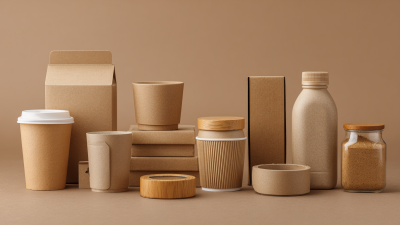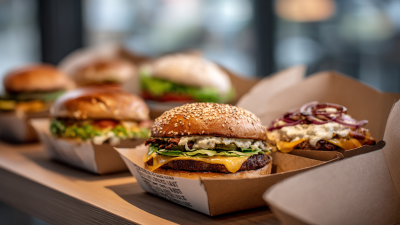Innovative Packaging Materials Transforming Sustainability in the Modern Age
In recent years, the shift towards sustainability has dramatically influenced various industries, particularly in the realm of packaging materials. According to a report by Grand View Research, the global sustainable packaging market is expected to reach USD 1,001.17 billion by 2026, growing at a CAGR of 5.7%. This surge in demand is driven by heightened consumer awareness and regulatory pressures to reduce environmental impact.

Innovative packaging materials, such as biodegradable plastics, recycled content, and minimalistic designs, have emerged as pivotal solutions in addressing these sustainability challenges. These advancements not only minimize waste but also enhance the overall efficiency of supply chains. As companies strive to meet consumer expectations and comply with stringent regulations, the exploration of cutting-edge packaging materials is vital in transforming the packaging landscape, ensuring that it aligns with the principles of sustainability for a greener future.
Exploring Biodegradable Alternatives to Traditional Packaging Materials
The growing concern for environmental sustainability has led to the exploration of biodegradable alternatives to traditional packaging materials. Conventional plastics, which take hundreds of years to decompose, contribute significantly to landfill waste and ocean pollution. In response, innovators are developing various biodegradable materials derived from natural sources, such as plant starch, cellulose, and even agricultural waste. These materials not only minimize environmental impact but also provide functional benefits, such as moisture resistance and durability.
Recent advancements in bioplastics have paved the way for more efficient production processes and enhanced material properties. For instance, polylactic acid (PLA) made from corn starch and polyhydroxyalkanoates (PHA) produced by microbial fermentation are gaining traction as viable substitutes. Their ability to break down under industrial composting conditions ensures that they do not linger in the environment. As consumer demand for sustainable products rises, the packaging industry is increasingly shifting towards these innovative materials, drastically reducing the carbon footprint and promoting a circular economy.
Harnessing Smart Packaging Technologies for Enhanced Sustainability
Smart packaging technologies are revolutionizing sustainability by incorporating advanced features that help reduce waste and enhance recycling processes. These innovative materials are designed to provide real-time information about product status, ensuring optimal freshness while minimizing spoilage. For example, temperature-sensitive labels can monitor conditions during transport, alerting manufacturers and consumers to changes that may compromise product integrity. This capability not only decreases food waste but also supports a more efficient supply chain.
Moreover, smart packaging often integrates biodegradable or recyclable components, further advancing environmental goals. Technologies such as QR codes on packaging allow consumers to access detailed information about the product's lifecycle, encouraging responsible disposal and recycling practices. By engaging consumers in sustainability efforts, brands can foster a deeper connection with their audience while promoting ecological consciousness. Such advancements in packaging not only represent a significant step forward in sustainability but also highlight the potential for innovation to drive positive change in industry practices and consumer behavior.

The Role of Recycled Materials in Eco-Friendly Packaging Solutions
Recycled materials are playing a pivotal role in the advancement of eco-friendly packaging solutions, fundamentally transforming the approach to sustainability in consumer goods. As companies increasingly recognize the environmental impact of their packaging choices, the utilization of materials that can be repurposed significantly reduces waste and promotes a circular economy. By integrating recycled plastics, paper, and other substrates, brands not only minimize their carbon footprint but also resonate with consumers who prioritize sustainability in their purchasing decisions.
Tips for incorporating recycled materials into your packaging strategy include seeking suppliers who specialize in sustainable resources and exploring various materials that can replace traditional options. It can also be beneficial to educate your team about the sourcing and lifecycle of recycled materials to foster a culture of sustainability within your organization. Furthermore, consider conducting a sustainability audit to identify areas where recycled materials could replace non-recyclable options, enhancing your overall eco-friendliness.
In addition to the immediate benefits of reduced waste, using recycled materials can lead to innovative packaging designs that differentiate your brand. Emphasizing a commitment to sustainability through unique and eye-catching packaging not only attracts environmentally conscious consumers but also encourages loyalty and repeat purchases. The shift towards recycled materials signifies not just a trend, but a necessary evolution in the packaging industry, marrying creativity with responsibility.

Innovative Design Strategies for Minimizing Packaging Waste
Innovative design strategies are playing a crucial role in minimizing packaging waste, a pressing concern in the modern age. According to a report by the World Economic Forum, around 300 million tons of plastic waste is generated globally every year, with a significant portion coming from packaging. To combat this issue, companies are increasingly adopting designs that prioritize recyclability and sustainability. For instance, modular packaging designs not only reduce material usage but also enhance the efficiency of transportation, thereby lowering carbon footprints.
Moreover, advancements in materials science have led to the development of biodegradable alternatives that serve as excellent substitutes for traditional plastics. The Ellen MacArthur Foundation's latest report states that innovative bioplastics can reduce carbon emissions by up to 80% over their lifecycle compared to conventional plastic. Continuous research in this field is driving the creation of packaging solutions that not only protect products but also minimize environmental impact. With companies recognizing the importance of sustainable practices, the integration of eco-efficient design strategies is becoming a standard, paving the way for a more sustainable future in packaging.
| Innovative Material | Sustainability Impact | Design Strategy | Waste Reduction Potential (%) |
|---|---|---|---|
| Biodegradable Plastics | Reduces landfill impact | Use of renewable materials | 50% |
| Recycled Cardboard | Decreases deforestation | Minimalist packaging design | 30% |
| Plant-Based Inks | Less toxic waste | Eco-friendly printing techniques | 20% |
| Edible Packaging | Eliminates plastic waste | Integration with product | 90% |
| Mushroom-Based Materials | Compostable and sustainable | Natural design aesthetics | 70% |
Consumer Awareness: Driving Demand for Sustainable Packaging Practices
Consumer awareness is playing a pivotal role in the transformation of sustainable packaging practices across various industries. As environmental concerns rise, more consumers are actively seeking products that prioritize eco-friendliness. The sustainable packaging market is projected to reach USD 737.6 billion by 2035, reflecting a remarkable compound annual growth rate (CAGR) of 10.30% from its current valuation of approximately USD 313.73 billion in 2025. This growth highlights the increasing demand for packaging solutions that use eco-friendly materials and designs aimed at reducing waste and promoting recyclability.
Moreover, the bottled water market exemplifies this shift, with a notable surge in demand for healthier hydration options driving the sector forward. As a response to growing consumer preferences, sustainable packaging solutions are gaining momentum, with significant sectors like cold food packaging expected to grow from USD 0.9 billion in 2023 to USD 1.8 billion by 2033, reflecting a steady 7.5% CAGR. Regulatory changes and heightened eco-awareness among consumers underline the industry's potential, reaffirming that sustainability is not just a trend but a crucial element of modern product offerings.
Consumer Awareness: Driving Demand for Sustainable Packaging Practices
Related Posts
-

The Ultimate Guide to Choosing Eco Friendly Packaging Supplies for Your Business
-

Creative Burger Packaging Ideas for Sustainable Fast Food Solutions
-

The Future of Sustainability in Carton Packaging Techniques and Innovations
-

Revolutionizing Sustainable Food Packaging Solutions for a Greener Future
-

Exploring Eco Friendly Innovations in Carton Packaging for Sustainable Brands
-

Innovative Trends in Food Packaging Design You Need to Know for Sustainable Choices
